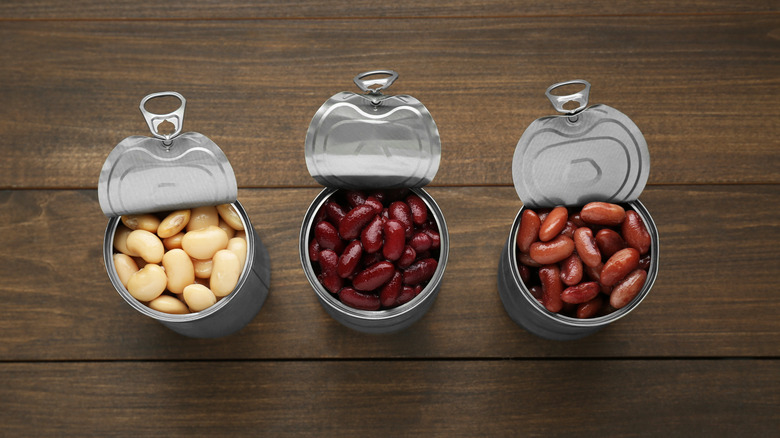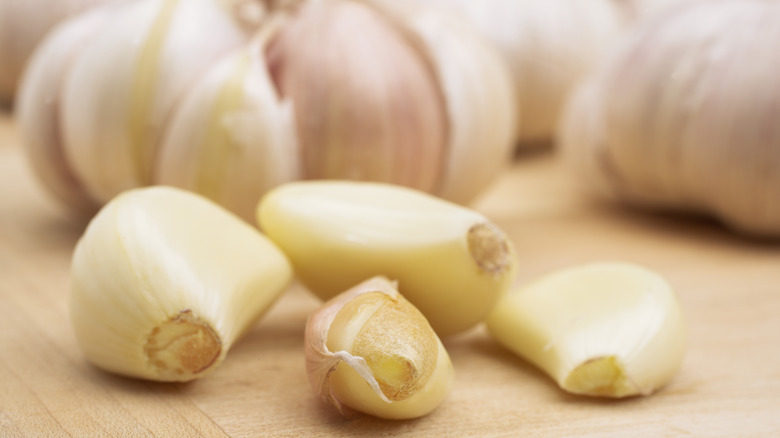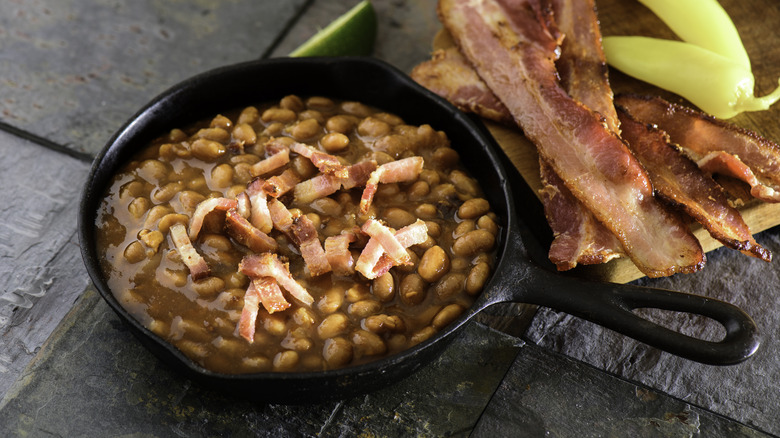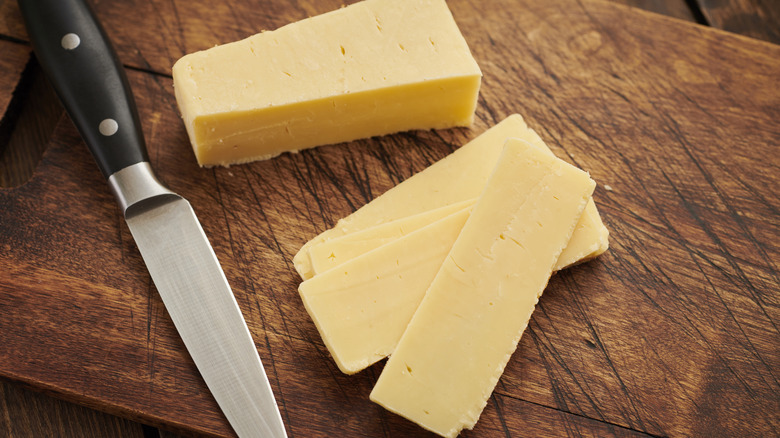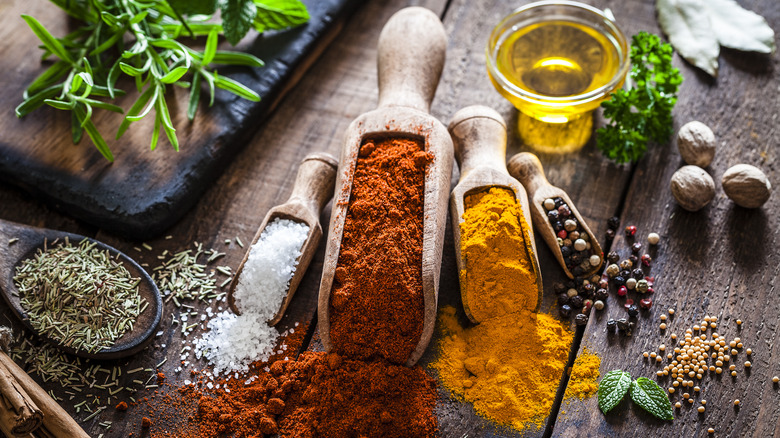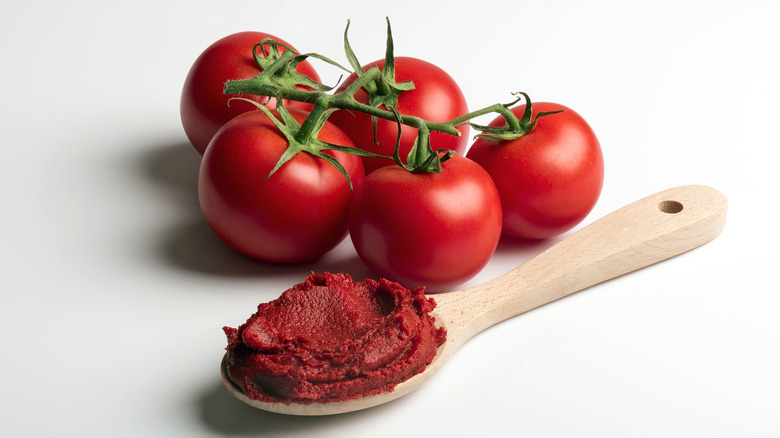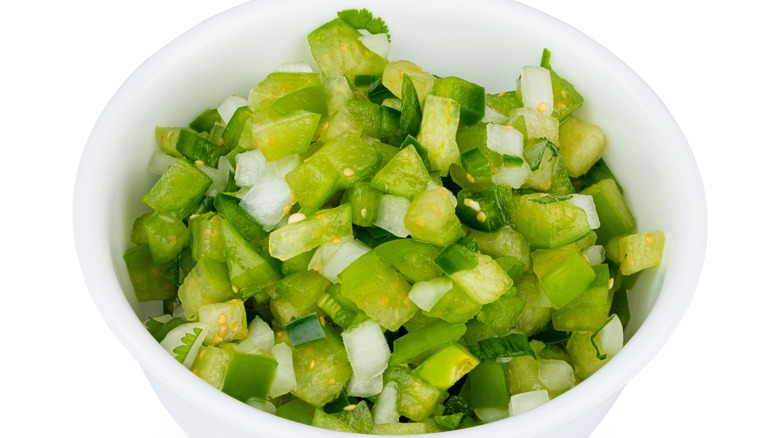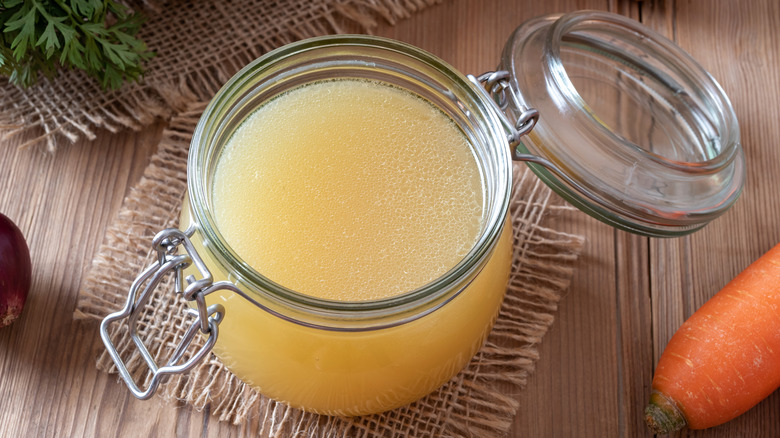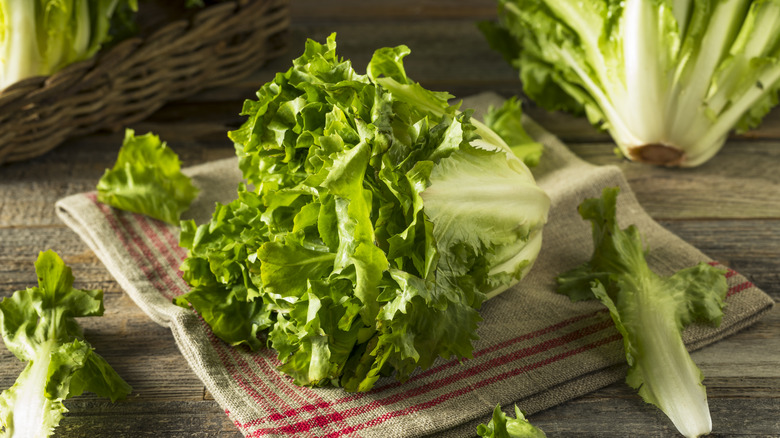Ingredients That Will Take Canned Beans Up A Notch
Many of us have cans of beans in our pantries: kidney beans, garbanzo beans (also known as chickpeas), black beans, pinto beans, navy beans, black eyed peas, red beans, and so on. We also all have bags of beans in the pantry too, but it feels like the cans get used more even though there are taste drawbacks. This is because we are very busy! Preparing dried beans can take more time than we have, especially on chaotic days. But don't worry. There are many ways you can take them from boring to delicious.
In general, beans are an excellent addition to any meal and are often the star of the show themselves. They are vegetarian, affordable, used in many different cultural dishes, and packed with protein and fiber. (But it doesn't stop kids from reciting that popular rhyme about beans). Still, canned beans are all of these; they're also convenient. However, they do lack a robust flavor and can even taste like the can. Sometimes, there's too much salt. Yes, there are low-salt versions of canned beans, but it still can be an issue. Here are some ways you can elevate your canned beans so they'll taste better than you expect.
Garlic
Is there anything garlic can't save? Add a can of beans to that list. But don't just throw a raw clove in and call it a day. Cooking canned beans with garlic requires you to cook the garlic first. When added to canned beans, garlic should be finely chopped and sauteéd first so it merges with the beans instead of overpowering them. Plus, when you sauteé garlic in olive oil, you unlock the flavor of the garlic in a more nuanced way and also introduce olive oil to the beans — which of course, makes them even tastier. You can also choose to use a garlic-infused olive oil if you're a fan.
Garlic pairs really well with cannellini beans, garbanzo beans, navy beans, and borlotti beans. Combine with other ingredients such as lemon, rosemary, thyme, and chili peppers (fresh or dried). Sprinkle some Parmesan on top and you've got a warm, zesty, and satisfying dish that could have been made in Tuscany instead of from a can of beans from your pantry.
Bacon or other pork fats
Beans and pork are a fantastic, classic combination. Imagine you're deep in the woods, sitting around a campfire, the sun setting behind you. What are you cooking over the fire? Maybe baked beans and bacon to spoon over a thick slice of toast. The meal is iconic at this point, conjuring both visions of cowboys in the old Wild West and slow barbecues in the South. The addition of bacon, lard, or pork will create a much richer flavor profile for kidney beans or red beans. The fat merges with the beans and adds saltiness, richness, and savoriness.
Depending on the kind of bacon or pork you use, those other flavors can bump up your beans in different ways — think smokier or sweeter. Some cooks prefer salt pork, which comes from pork belly as well as the pig's back and contains lots of fat. If you're using salt pork, you can cook it right into the bean mixture. Other cooks prefer bacon. Cook the bacon first until it's crisp, then add it to any kind of bean for an instant flavor upgrade and crunchier texture.
Cheese
Adding some cheese to your canned beans is a winning move. Stirring in a chunk of sharp cheddar to black beans gives them a necessary kick and also a delicious creaminess. Some beans and cheeses go better together than others. For example, the earthiness of black beans, pinto beans, and red beans work well with cheese like cheddar, Cotija, and Manchego. Beans with a nuttier and more mellow profile such as garbanzo beans and cannellini beans benefit from Parmigiano, pecorino, and feta.
Put all of this cheesy goodness together with other simple ingredients. Bean burritos are a great way to elevate your canned black beans using cheese. Get some good flour or corn tortillas and add the bean and cheese mixture. You can also add fresh vegetables like diced tomatoes, jalapeño, and squeeze some lime juice on top. With cannellini beans and grated Parmigiano cheese, you can load them on a piece of crusty Italian bread and then drizzle on extra virgin olive oil and squeeze some lemon.
Herbs and spices
There are so many herbs and spices you can use to amp up canned beans. Depending on the kind of bean you're using and the kind of flavors you want to emphasize, you can get really creative. Salt and cracked black pepper work well with any type of bean, but always check the salt content first, as the saltiness of canned beans can be an issue for some. When cooking canned beans with spices, you can either add them in their powdered form or crush up whole seeds and sauté them in olive oil for a more vivid taste. You can also toast the spices before crushing them.
For earthier tasting beans, add spices like chile powder, paprika, turmeric, cumin, and ginger. Here's where you can play around with Indian flavors for spicy, savory beans, including pot rajma, a kidney bean curry. For beans with a nuttier profile, fresh rosemary, sage, thyme, and even mint are herbs that work well to brighten your dish. You can even upgrade with pesto — homemade or store brought — as an already herb-packed addition to canned bean-based meals.
Tomato paste
Maybe you've recently checked your pantry and found a few cans or tubes of tomato paste that you've forgotten about. It's one of those ingredients you pick up at the store over and over again, with grand plans, and then end up neglecting. But it's a great way to add depth and savoriness to beans. If you want saucy beans (think like minestrone) but not soupy beans, tomato paste should be your best friend.
Why is tomato paste different from regular canned tomatoes? Well, it's made from fresh tomatoes that have been cooked down to reduce moisture. The tomatoes are then pureed and strained so the seeds and skin are removed. Then it's reduced even more and concentrated into a thick paste. Pouring out tomato paste can take a while. Canned tomatoes have more moisture and are less concentrated. Tomato paste is packed with savory flavor (or umami), so it's often used very sparingly when cooking. But tomato paste may just be the secret to adding more flavor to canned beans.
White onion and jalapeño
When sauteed together and added to canned black beans, white onion and jalapeño can help kick them up a notch in flavor and spice. White onions, in particular, pairs well with Mexican and Mexican-inspired dishes because they're milder and brighter, so they're a good complement to the spice and a robust seasoning in a lot of these cultural dishes. They're also excellent to use in salsas and guacamole. When combined with canned black beans, white onions and jalapeños work their magic to transform them from dull to dazzling.
First, chop up the onions and cook them in olive oil. Then add the jalapeño so they retain some of their crunch. When the onions are translucent, add the beans. Play around with your favorite spices and preferred heat levels. Add cheese! You can take this dish to so many delicious places. It all starts with a humble can.
Broth or stock
Canned beans come with their own liquid — this strange, gloppy paste that you don't always know what to do with. Do you rinse the canned beans and wash that liquid down the drain? Do you keep the liquid for flavor and consistency? Or do you rinse the canned beans every time? There is, however, a liquid you don't want to miss out on when you want to improve your canned beans — stock or broth. Stock adds a rich, savory flavor that elevates almost any food that needs to be cooked with water. Beans are no exception, whether you're making soup or scanning the cupboard for a quick way to take your beans to another level.
The difference between stock and broth is not terribly significant but it can affect your food, especially when you're choosing the kind of meal you want to make. Stock is made with bones that have been boiled and then simmered in water for at least six hours. It's less flavorful but perfect for use as a base in sauces and when cooking rice, beans, and other grains. Broth is made from meat that's simmered in water with vegetables and herbs. It has a richer flavor and can be used when the dish calls for a rich liquid, such as soup. But what about those bouillon packets or cubes we all have? You can also grate your bouillon cubes to make them more manageable.
Escarole
Escarole and beans is one of the all-time great side dishes and soups. It's a comforting and easy meal — and the perfect way to use canned white beans. This meal combines the fresh, lightly bitter taste of the escarole with the hearty beans. Garlic, onions, broth, herbs, and spices then all work together to make magic. Known as a classic Italian dish, you can make a huge pot of this to accompany fresh crusty bread and Parmigiano cheese. You can play with the consistency and textures, making more of a soup than a stew or side dish depending on your preferences.
If you can't find escarole, use one of the many varieties of kale, such as Tuscan, or another robust green. For example, if you'd like to make a Tuscan white bean soup, add onions, carrots, and celery. Another option is ribollita, a Tuscan bread soup. This is another great way to use escarole or kale and white beans. It's also a perfect way to use up stale bread!
Extra virgin olive oil
Every house should have at least two types of olive oil — one for cooking and one for dressing. Canned beans, especially cannellini beans, navy beans, and chickpeas, are perfect to dress up with extra virgin olive oil. Look for brands that range in color from deep golden to light green. Do some research on olive oil regions and their associated tastes. Do you prefer a peppery taste? A fruity one? Something mild or something robust? Mediterranean countries are some of the most well-known for producing olive oil due to the abundance of olive trees native to these regions so you might see lots of olive oil from countries like Italy, Spain, or Greece.
You can infuse your olive oil with all sorts of delicious things, too, for a more personalized touch. Steep garlic cloves in olive oil for a rich and zesty flavor. Rosemary oil goes wonderfully with white beans too. And don't forget hot pepper infused oils. You can buy infused oils at the store, but sometimes it's more fun to play around with these flavors and combinations at home to really beef up your beans.
